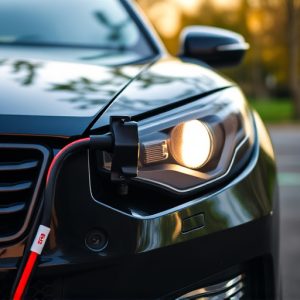Boat Battery Health: Unraveling Issues and Optimizing Performance
Maintaining a boat battery requires careful attention to detail, considering the unique environmental challenges boats face such as temperature fluctuations and saltwater exposure. To ensure longevity and reliability, it's crucial to understand proper voltage and capacity, with batteries provi…….

Maintaining a boat battery requires careful attention to detail, considering the unique environmental challenges boats face such as temperature fluctuations and saltwater exposure. To ensure longevity and reliability, it's crucial to understand proper voltage and capacity, with batteries providing essential power for marine electronics, engine starting, and lighting. Optimal maintenance includes regular cleaning of terminals, monitoring electrolyte levels, and adhering to the correct charging procedures. Boat owners should also consider the battery type most suitable for their vessel's specific needs, whether it's a traditional lead-acid or a more modern AGM or lithium option. Proactive measures like checking charge levels, managing storage conditions, and using advanced charging equipment can prevent issues like sulfation and extend the life of your boat battery. Regular upkeep and understanding the intricacies of your battery will ensure consistent performance and reliability on the water.
When setting sail on the open waters, boat owners rely heavily on their marine batteries to power vital electronic systems. Yet, despite their critical role, these batteries can sometimes falter, leaving you stranded or without essential navigation tools. This article demystifies the reasons behind battery issues and provides actionable solutions for maintaining optimal performance. We’ll explore the intricacies of boat battery functionality, pinpoint common causes of malfunctions, consider environmental impacts on battery health, and outline maintenance best practices to prevent future problems. With a comprehensive approach, you can extend your boat battery’s lifespan and ensure it remains reliable throughout your voyages.
- Understanding Boat Battery Functionality: The Role of Voltage and Capacity
- Common Causes Behind Boat Battery Issues: A Deep Dive
- Environmental Factors Influencing Marine Battery Performance
- Maintenance Mistakes Leading to Boat Battery Malfunctions
- Step-by-Step Troubleshooting for Boat Batteries: Identifying and Resolving Problems
- The Importance of Regular Testing and Monitoring for Your Boat's Battery Health
- Strategies for Optimizing Boat Battery Lifespan: Best Practices for Maintenance and Usage
Understanding Boat Battery Functionality: The Role of Voltage and Capacity

When delving into the functionality of boat batteries, it’s crucial to grasp two key concepts: voltage and capacity. These elements determine a battery’s performance and longevity while powering your marine electronics, starting the engine, or providing lighting on the water. Typically, boat batteries are lead-acid or absorbed glass mat (AGM) types, designed to operate at 12 volts for most applications. The voltage is a measure of electrical potential difference, indicating the force that drives current through a circuit. In a 12-volt system, this voltage can be sourced from a single battery or the series combination of two or more 6-volt batteries. The capacity, often measured in ampere-hours (Ah), signifies the total amount of charge the battery can hold and is directly related to its size and the materials used in its construction. A higher capacity means the battery can deliver power for a longer period before needing recharge. Understanding these aspects is vital for maintaining optimal battery health and ensuring your boat’s electrical systems function reliably, regardless of the conditions encountered on the water. Regular maintenance practices, such as keeping terminals clean and checking electrolyte levels in flooded batteries, play a role in upkeep. Additionally, charging the battery properly after use and selecting the right battery for the application can prevent issues related to voltage fluctuations and capacity shortfalls, thus extending the battery’s service life.
Common Causes Behind Boat Battery Issues: A Deep Dive

Boat batteries, a critical component for any maritime vessel’s electrical systems, are subject to a unique set of challenges that can lead to issues such as poor performance or complete failure. Understanding the common causes behind these problems is essential for boat owners aiming to maintain their vessels’ reliability and functionality. One prevalent cause of battery issues in boats is exposure to varying temperatures; batteries can suffer from sulfation when subjected to prolonged cold, or they may overheat and lose capacity if used frequently in warm climates. Another factor is the type of charging system employed. Incorrect charging parameters can lead to improper battery charging, causing a reduction in lifespan and efficiency. Additionally, the state of charge and depth of discharge (DOD) play significant roles; frequent deep discharges without proper recharging cycles can degrade the battery’s ability to hold a charge. The buildup of sulfation on the lead plates, often due to incomplete charging, reduces the surface area for electrical reactions and impairs performance. Furthermore, connections and terminals must be kept clean and tight; corrosion or loose connections can impede current flow and lead to voltage drops or complete loss of power. Regular maintenance, including checking fluid levels in flooded cells and ensuring that the battery is securely mounted to prevent movement that can cause internal damage, is crucial for preventing issues related to boat batteries. By addressing these common causes through proactive maintenance and understanding the correct charging protocols, boat owners can significantly reduce the likelihood of battery-related problems on the water.
Environmental Factors Influencing Marine Battery Performance

Marine batteries, much like their automotive counterparts, are subject to a myriad of environmental factors that can influence their performance and longevity. The harsh marine environment presents unique challenges for boat batteries, including exposure to saltwater, high humidity, and varying temperatures that can significantly affect their functionality. Saltwater, in particular, can be particularly detrimental as it can lead to corrosion of terminals and connections, which impedes the battery’s ability to hold a charge. This corrosion often manifests as a white or green crust on metal components, and if not regularly cleaned and maintained, it can compromise the electrical integrity of the battery system.
To mitigate environmental factors that affect marine battery performance, it is crucial to implement proactive maintenance strategies. Regular cleaning of terminals and connections with a mixture of baking soda and water can prevent salt buildup. Additionally, using a battery combinator or casing that isolates the battery from the hull can protect against galvanic corrosion, a common issue in marine settings. It is also advisable to choose batteries designed specifically for maritime use, as these are often manufactured with materials and features that offer greater resistance to the elements. Regular inspections and prompt repairs of any damage or corrosion will ensure that your boat battery performs reliably, no matter how long it spends on the water.
Maintenance Mistakes Leading to Boat Battery Malfunctions

When it comes to maintaining a boat battery, certain oversights can lead to frequent malfunctions and reduced lifespan. One prevalent mistake is neglecting to keep the battery clean and free from corrosion. The terminals on a boat battery should be regularly inspected and cleaned to ensure optimal conductivity. Dirt, salt, and other contaminants can accumulate on these terminals, causing a poor connection that hinders the battery’s ability to hold a charge. It’s also crucial to maintain proper water levels in lead-acid batteries; an imbalance can cause the plates inside to degrade quickly. Similarly, overcharging or undercharging the battery can lead to sulfation, which impairs its performance and can eventually lead to failure.
Another common maintenance mistake is not storing the boat battery properly during off-season periods. Leaving a battery fully charged or discharged for extended periods can damage the cells. Ideally, boat batteries should be stored at a moderate state of charge and in a cool, dry environment to prevent self-discharge and protect against extreme temperatures that can accelerate aging. Regularly checking the electrolyte levels and adding distilled water as needed is also essential. Additionally, using the wrong type of charger or not charging the battery properly after use can cause significant issues. It’s important to use a charger that is compatible with the battery type and to follow the manufacturer’s recommendations for charging cycles and durations to ensure the boat battery operates reliably.
Step-by-Step Troubleshooting for Boat Batteries: Identifying and Resolving Problems

When encountering issues with boat batteries, a systematic approach to troubleshooting can often resolve the problem and restore power. The first step is to conduct a visual inspection of the battery terminals and cables. Corrosion on terminals or loose connections can significantly impact the battery’s performance. Clean the terminals with a wire brush and ensure all connections are tight. If the battery still isn’t holding a charge, proceed to check the charge level. A boat battery should be fully charged for optimal operation. Use a hydrometer or digital multimeter to test each cell in the battery. Low charge levels can be remedied by charging the battery using a suitable charger designed for marine batteries.
If the battery remains unresponsive after charging, it’s important to inspect the battery itself for any signs of damage, such as bulging cases or cracked cells. Damage to the battery can compromise its ability to hold and deliver power. If no visible damage is present, the next step is to examine the alternator and charging system. The alternator must be functioning correctly to recharge the battery while the boat is running. Check for proper voltage output and repair or replace faulty components as necessary. Lastly, consider the battery’s age and usage patterns. Over time, batteries naturally lose their ability to hold a charge; thus, regular maintenance and timely replacement are crucial for consistent performance. By following these steps methodically, you can effectively identify and address issues with boat batteries, ensuring your maritime adventures remain uninterrupted by power problems.
The Importance of Regular Testing and Monitoring for Your Boat's Battery Health

Regular testing and monitoring of your boat’s battery health are critical practices that can extend the life of your marine battery and ensure its reliability on the water. Over time, factors such as temperature fluctuations, vibrations from the sea, and electrolyte levels can impact battery performance. A routine testing schedule allows you to identify issues like sulfation buildup or a decrease in capacity before they lead to unexpected failures. By regularly checking your boat’s battery voltage and charge level, you can proactively address any anomalies. This preventive approach is particularly important for deep-cycle batteries, which are designed for frequent discharges and recharges typical of boating applications. Additionally, monitoring the battery’s state of health through hydrometer readings or digital testers can provide valuable insights into its condition, enabling timely maintenance actions such as topping off electrolyte levels or adjusting charging systems to maintain optimal performance. Implementing a systematic testing regimen not only enhances safety by reducing the likelihood of battery failure but also safeguards your investment in your boat’s power source, ensuring it performs when you need it most on the open seas.
Strategies for Optimizing Boat Battery Lifespan: Best Practices for Maintenance and Usage

Maintaining a boat battery in peak condition is crucial for ensuring it has a long and reliable lifespan. To optimize the performance and durability of your boat battery, employ a set of proactive maintenance strategies. Firstly, regularly check the water levels in flooded lead-acid batteries, as maintaining proper electrolyte concentration is essential for optimal charge acceptance and longevity. For sealed or maintenance-free batteries, monitor the charge indicator regularly to ensure they are fully charged after use. Keep your battery clean by removing any corrosion from terminals and cleaning connections with a mixture of baking soda and water. Storing your boat in a climate-controlled environment can prevent extreme temperature fluctuations that can shorten a battery’s life. Additionally, avoid draining the battery completely; keeping it within the 50% to 75% charge range can extend its lifespan. Regularly run the engine and use onboard electrical systems to keep the battery exercised. Lastly, consider investing in a battery charger with a desulfation feature or a smart battery maintainer to keep your boat battery fully charged and healthy. By following these best practices for maintenance and usage, you can significantly enhance the lifespan of your boat battery and ensure it performs reliably whenever you set sail.
When addressing issues with boat batteries, understanding their functionality and the factors that can lead to malfunctions is crucial. This article has shed light on the essential aspects of maintaining optimal performance for your marine battery. From exploring the roles of voltage and capacity to examining environmental impacts, we’ve delved into common causes behind battery problems and provided a comprehensive troubleshooting guide. Regular testing and monitoring, coupled with best practices in maintenance and usage, are key to extending your boat battery’s lifespan and ensuring its reliability. By adhering to the strategies outlined, boat owners can effectively prevent and resolve issues, ensuring smooth and uninterrupted marine adventures.







